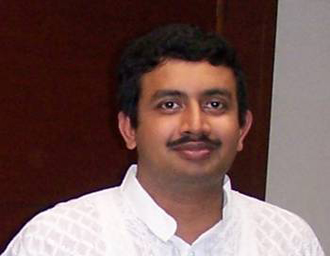Anirban Banyopadhyay Unveils Molecular Parallel Processor
By wchung | 28 Dec, 2025
Anirban Banyopadhyay has assembled 300 organic molecules into a massively parallel nanoscale computing device.
Anirban Banyopadhyay unveiled what amounts to a massively parallel nanoscale computing device that uses a single layer of 300 organic molecules that can each be flipped to four different states.
Bandyopadhyay’s team achieved this feat by using a molecule called 2,3-dichloro-5,6-dicyano-p-benzoquinone (DDQ) which forms a ring that can each link to between 2 and 6 other DDQ molecules. What makes DDQ molecules well suited to serve as molecular computing units is their ability to flip among four different conducting states depending on the location of trapped electrons around the ring.
Each DDQ molecule can be switched from one state to another by zapping it with voltages of varying strengths with the tip of a scanning tunneling microscope. An electric field can be applied to bias the DDQ molecules’ possible states, making them even more versatile as the units of a computing device.
A change in the state of one molecule causes a ripple effect in the states of successively linked circuits of DDQ molecules. Because each molecule links to between 2 to 6 neighbors, state changes take place in parallel, mimicking the highly efficient parallel computing of brain neurons which can communicate with up to 1,000 other neurons at a time.
Bandyopadhyay’s team has configured their molecular computing device to represent the way heat diffuses in a conducting medium and the way cancer spreads through tissue as a demonstration of the kind of “visual computing” it can perform exceptionally well, offering a glimpse into a possible technique for mimicking the capabilities of the human brain. The brain’s parallel structure allows it to outperform even the latest computer chips that can process in the range of 10 quintillion bits per second.
Bandyopadhyay’s molecular computing device — which he has been tinkering with in various states for several years — is a conceptual breakthrough but a far cry from being a practical parallel processor. For one thing, it still requires the use of a scanning tunneling microscope, a large piece of equipment, to transmit the initial impulse. The DDQ molecules must be deposited on an expensive gold substrate, another impediment to building a practical and economical computing device.
Bandyopadhyay first displayed the concept in March 2008 on a smaller scale by linking 17 molecules arranged on a gold substrate. That device comprised 16 molecules forming a weakly bonded ring around the central molecule which served as the machine’s control unit. He said he had modeled the system on how glial cells work to pass along instructions among neurons in the nervous system and that the architecture looks “almost like the neural network inside our brain.” He said at the time that a single instruction given to the control unit could generate more than 4 billion (416) possible outcomes.
His latest DDQ device takes Dandyopadhyay a step closer to his ultimate goal of building an intelligent parallel bio-processor based on neural networks using cellular automata like an organic monolayer.
Anirban Bandyopadhyay was born and raised in India. Between November 2003 and April 2004 he worked in the area of DNA nano-electronics to create a neural network and to re-fuel organic solar cells using Calf-thymus DNA as a visiting scientist at the School of Engineering of Sheffield Hallam University in Sheffield, England. During that period he also worked on a project for the US Air Force.
From May of 2004 to January of 2005, as a senior research fellow at the Indian Association for the Cultivation of Science (IACS) in Kolkata India, he worked on molecular memory switching devices using simultaneous optical and electronic control of a memory-bit.
In 2005 Bandyopadhyay completed his PhD in supramolecular electronics at IACS. That February he joined the National Institute for Materials Science (NIMS) in Tsukuba, Japan as an independent molecular electronics researcher for Japan’s International Center for Young Scientists (ICYS). In April of 2008 he was promoted to his current position as a NIMS senior researcher.

India native Anirban Banyopadhyay is a senior researcher at Japan's National Institute of Material Science.
Articles
- China Issues Draft Rules for AI Simulating Human Personality
- China Revises Laws to Bolster Ability to Wage Trade War
- China's November Industrial Profits Sank at Fastest Pace in Over a Year
- Boeing, Anduril Among Defense Firms Sanctioned by China
- New York to Require Mental Health Warnings for Social Media
Asian American Success Stories
- The 130 Most Inspiring Asian Americans of All Time
- 12 Most Brilliant Asian Americans
- Greatest Asian American War Heroes
- Asian American Digital Pioneers
- New Asian American Imagemakers
- Asian American Innovators
- The 20 Most Inspiring Asian Sports Stars
- 5 Most Daring Asian Americans
- Surprising Superstars
- TV’s Hottest Asians
- 100 Greatest Asian American Entrepreneurs
- Asian American Wonder Women
- Greatest Asian American Rags-to-Riches Stories
- Notable Asian American Professionals

